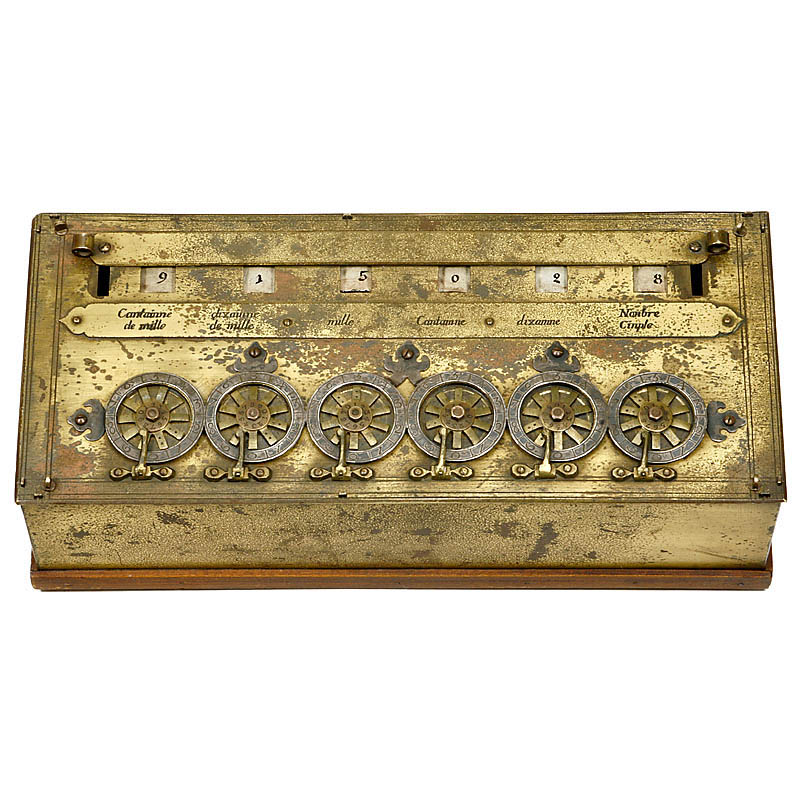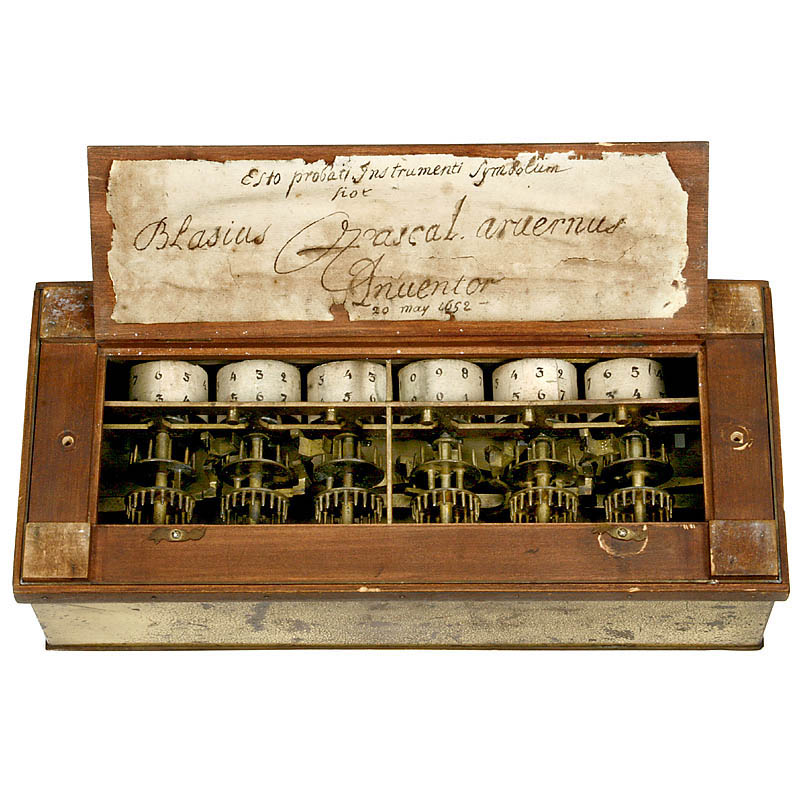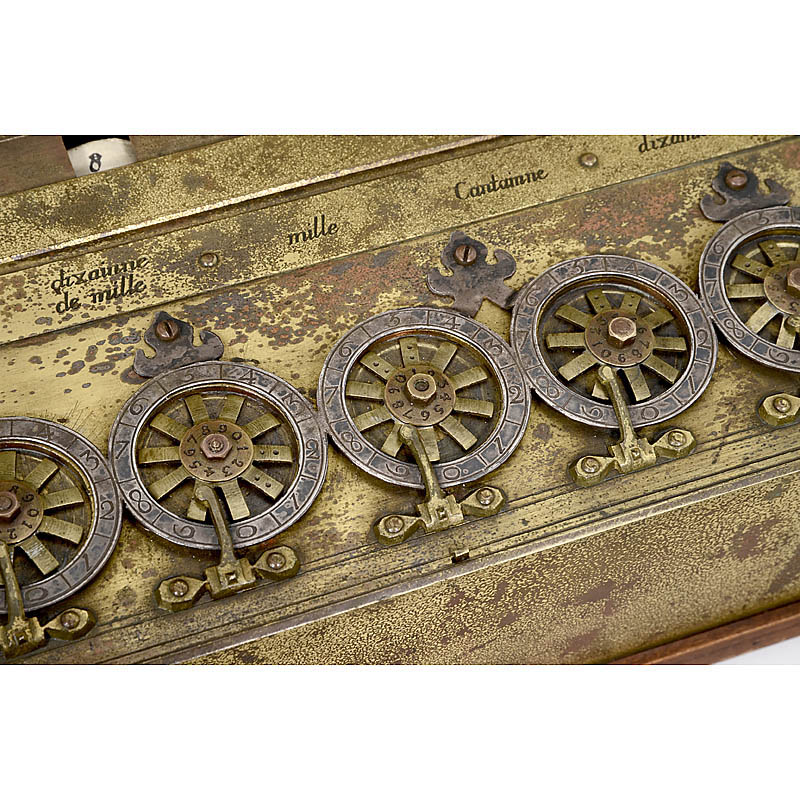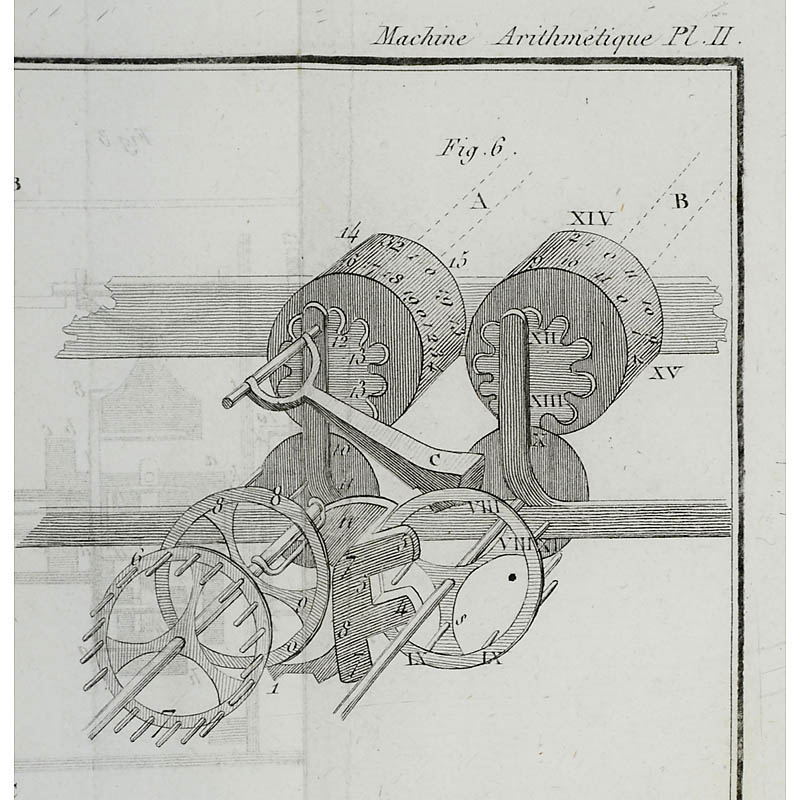









With lacquered-brass case, spoked digit-wheels with engraved white-metal scales corresponding (right to left) to: "Nombre Cimple", "dixaine", "Cantainne", "mille", "dixaine de mille" and "Cantainne de mille", sliding rule for changing display from addition to subtraction, brass-framed interior mechanism with six axles each carrying three lantern gears (some pins missing) and an inscribed paper-covered drum for the display,
on wood plinth with four square feet and hinged flap with paper label inscribed "Esto probati Instrumenti Symbolum siot. Blasias Pascal arvernus Inventor 20 May 1652", width 11 ¼ in. (28,5 cm) x depth 5 1/8 in. (13 cm) x height 3 in. (7,8 cm). Blaise Pascal (1623–1662), mathematician, physicist and philosopher, is credited with the invention of the first mechanical calculator capable of addition and subtraction. His
father, Étienne Pascal, was a lawyer and a judge in the tax court who assumed a new position as tax commissioner for Upper Normandy, based in Rouen, in 1639. France had declared war with Spain four years earlier, leading the French government to renege on part of its
internal debt and to increase taxation. Étienne – assisted by his son – was under pressure to keep accurate account of the rising tax levies with only the help of counting boards. In 1642 the 19-year old Blaise began designs for a machine that would simplify his father's
work. As a reviewer wrote in Le Figaro Littéraire in 1947, "the calculating machine was born of a filial love flying to the rescue of the tax man". Pascal's first design was for a five-digit calculator; he later refined his principal by creating six and eight-digit machines.
Due to the difficulty in cutting toothed gears accurately, Pascal used lantern-type gears formed by pinned wheels that could turn in one direction only. His design was simultaneously simple and brilliant; the Pascaline could add and subtract two numbers directly and multiply and
divide by repetition. The six digit-wheels on the outer case are connected to axles that each carry three lantern gears and a paper-covered drum with inscribed figures. The digit-wheels were rotated by a stylus. For addition, a sliding rule located on the number display
was pushed upwards for digits from 0–9. For subtraction, the rule was pushed downwards for digits from 9–0. The Pascaline was also revolutionary for including digital carry-over. Whenever a ten was carried, a ratchet mounted between the gears, pushed the adjacent gear around a notch, so that the display moved one digit higher. Unfortunately for its operator, a design flaw meant that the ratchets were inclined to jamperhaps one reason why production of the Pascaline was not financially successful at 100 Livres apiece. It was, however, a mathematical sensation, leading Pascal's friend, the poet Charles Vion Dalibray, to compose a sonnet in its honor: – "... Calculation was the action of a reasonable man, And now your inimitable skill.
Has given the power to the slowest of wits". – Pascal accordingly applied for a privilege (the 17th Century term for a patent), which was only eventually granted in 1649, after its inventor had presented the issuing officer, Chancellor Seguier, with an 8-digit calculator of his own.
The total production of the Pascaline is not known, however, researchers estimate that no more than 20 examples were produced, of which 9 are known today. It was, nevertheless, an historic achievement, not least for demonstrating "that an apparently intellectual process like arithmetic could be performed by a machine". Its introduction led to the development of mechanical calculators in Europe and, eventually, to the invention of the very first microprocessor, the "Intel 4004", for the "Busicom 141-PF" electronic desk calculator in 1971 (see the following lot). Understood
in this way, the Pascaline is arguably world's earliest mechanical computer. – Literature: Stan Augarten, "Bit by Bit, An Illustrated History of Computers", 1984, pp. 22–30. – An important instrument of inestimable historical and technical value!
拍品描述更正:
由布雷斯·帕斯卡 Blaise Pascal(1623-1662)发明的机械计算器
经历史考证的帕斯卡计算器,具有布雷斯·帕斯卡1652年的设计和功能
有关该拍卖品的信息出版后,有科学研究和实验室分析证实,正在竞拍的这款计算器应为二十世纪初期的一款六位帕斯卡计算器,它与帕斯卡最初设计的那款仅有如下几处不同:
1. 九个公认的原版帕斯卡计算器上的大灯笼齿轮是从几块固体金属上整体雕刻而来,而此款型号上的进针是单独镶嵌进齿轮的。
2. 光谱分析显示此款帕斯卡计算器的盒体是镀铜的,制作时间为十九世纪末期。其风格和制作工艺与原版帕斯卡计算器相同。
3. 数字盘上的刻度的字体与存放于CNAM(国立工艺美术学院,巴黎)的1652年的帕斯卡计算器上的相同,但是字号稍大。
4. 此款帕斯卡计算器的螺丝的螺纹是M3或M4号的,均为1919出产的尺寸。螺纹规格说明本拍卖品成产于二十世纪二十年代。如果将它与另一款由任职于CNAM的钟表专家罗尼翁(E. Rognon)1926年制作的存放于伦敦科学博物馆的帕斯卡计算器比较的话,那该结论就更显而易见了。这两款计算机均与IBM公司的复古六位计算器相同,却与其后来的复制品相去甚远。
5. 标签为旧纸上的手写复本(大概有80到150年历史),并非摄影复本。
需要注意的是,在九个现知的原版帕斯卡计算器中,这些由布雷斯·帕斯卡设计-----而非手工制作-------的计算器同样各自存在差异!
这款帕斯卡计算器在此前一直为一个古老的加拿大家庭所持有。 和存放在巴黎CNAM的1652年的帕斯卡六位计算器来比,这是一款精致的,精确的,制作工艺良好的实用版本型号计算器。
鉴于以上信息,预估价为 25000-40000欧元,起拍价为18000欧元
Lot 12: "The Pascaline" (or: "Arithmatique") -Calculator by Blaise Pascal (1623 – 1662)
Historically accurate older model of the ‘Pascaline’ after the original design by Blaise Pascal, 1652.
Since going to press, additional scientific research and laboratory analysis have confirmed that the instrument on offer is an historically accurate early 20th century working-model of a six-digit Pascal calculator that differs from the original only in the following points:
1. The large lantern gears in the 9 known original Pascal machines were all cut from solid pieces of metal whereas the pins on this working model are inserted individually into wheels.
2. Spectral analysis reveals that the housing is of lacquered brass, and it is dated from the end of the 19th century. It is of the same style and construction as the 9 known original Pascal calculators.
3. The engraving on the upper plate is in the same script but with a slightly larger font than on the 1652 example in the CNAM (Conservatoire National des Arts et Metiers, Paris)
4. The screws on this working model have either M3 or M4 thread - a size only introduced in 1919. The screw-thread suggests that the machine was produced in the 1920s, especially when compared to an- other ‘Pascaline’ calculator with nearly identical characteristics in the collection of the Science Museum in London, which is known to have been built by E. Rognon, horologist and employee of CNAM, in 1926. Both machines correspond to the vintage 6-digit model in the IBM collection in New York but bear only little similarity to the more recent IBM replicas.
5. The label is a handwritten facsimile on old paper (of approx. 80 – 150 years) not a photographic copy.
It should also be noted that as Blaise Pascal designed - but did not physically build – any of his calculators himself, variations exist even between the 9 known original examples !
This Pascal-pattern calculator was until recently in the possession of an old Canadian family. It is a fine, accurate and well-engineered older working model of the six-digit 1652 calculator in the CNAM in Paris.

